"Because the charge placed on the droplets is a function of the droplet size, the size spectrum can be determined ..." 1
"An Instrument Employing a Coronal Discharge for the Determination of Droplet-Size Distribution in Clouds"
Summary
Electrical charges imparted to water drops allowed easier measurement of impingement on cylinders.
Key Points
- This was a multicylinder instrument that relied on the differential collection efficiency of different cylinder sizes.
- The measurement of electrical charge allowed easier measurement of impingement rates.
- There does not appear to be further use or development of the instrument.
Abstract
A flight instrument that uses electric means for measuring the droplet-size distribution in above-freezing clouds has been devised and given preliminary evaluation in flight. An electric charge is placed on the droplets and they are separated aerodynamically according to their mass. Because the charge placed on the droplets is a function of the droplet size, the size spectrum can be determined by measurement of the charge deposited on cylinders of several different sizes placed to intercept the charged droplets. An expression for the rate of charge acquisition by a water droplet in a field of coronal discharge is derived. The results obtained in flight with an instrument based on the method described indicate that continuous records of droplet-size spectrum variations in clouds can be obtained. The experimental instrument was used to evaluate the method and was not refined to the extent necessary for obtaining conclusive meteorological data.
The desirable features of an instrument based on the method described are (1) The instrument can be used in clouds with temperatures above freezing; (2) the size and the shape of the cylinders do not change during the exposure time; (3) the readings are instantaneous and continuous; (4) the available sensitivity permits the study of variations in cloud structures of less than 200 feet in extent.
Discussion
This method uses the physics of the differential collection efficiency of water drops on cylinders of different diameters.
The cylinder diameters used (1/8, 1/2, 1, and 3 inches) were typical of the NACA-era multicylinders instruments.
However, rather than weighing the ice accumulated on cylinders, the rate of electric charge from the charged water drops impinging could be measured, which was proportional to the water mass.
More information on multicylinder instruments can be found in the Icing on Cylinders Thread.
Note that:
A part of the method presented in this report has appeared in a dissertation titled "Some Aspects of Aircraft Icing Problem and an Instrument for Its Study" by Rinaldo J. Brun presented to the faculty of the Yale School of Engineering in June 1949 in candidacy for the degree of Doctor of Engineering.
I have not been able to find a copy of that dissertation. However, even though the instrument is described as a "means for measuring the droplet-size distribution in above-freezing clouds", the dissertation title indicates that the intended use was for icing research (eventually).
DESCRIPTION OF INSTRUMENT An instrument based on the principle of operation described in the preceding section was constructed. The instrument comprised four air-stream channels back to back as shown in figure 5. Needles were inserted through the cathode plate to aid in obtaining a uniform coronal discharge. The needles protruded through both sides of the cathode plates; thus each plate acted as a cathode for two air-stream channels. Cylinders of four different sizes were installed directly behind the region of coronal discharge (fig. 6). The assembly was hung from the under side of the fuselage of a twin-engine light-bomber-type airplane (fig. 7).
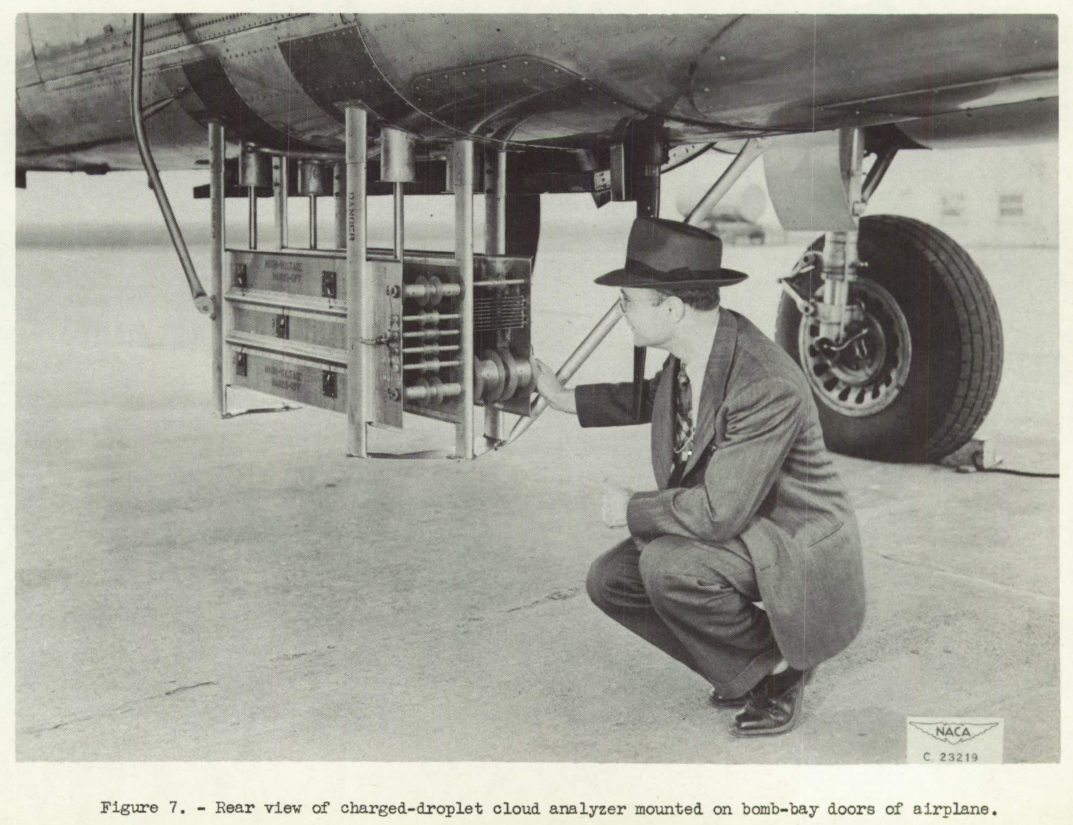
Figure 7 from NACA-TN-2458
Details of the circuits are not shown, but the device could produce 25,000 VDC to charge the water drops entrained in the air flowing through it.

Figure 5 from NACA-TN-2458
The cylinder diameters used were 1/8, 1/2, 1, and 3 inches. The number of cylinders used of each particular size was governed by the total charge intercepted by each size of cylinder. A larger number of the smaller-sized cylinders was required in order to obtain a measurable current of 2 microamperes. The cylinders of any one size group were wired in parallel. The spacing between cylinders was large enough to avoid aerodynamic interference of the cylinders with each other. Cylinders of the same diameter where ganged together were spaced 14 radii from center to center.
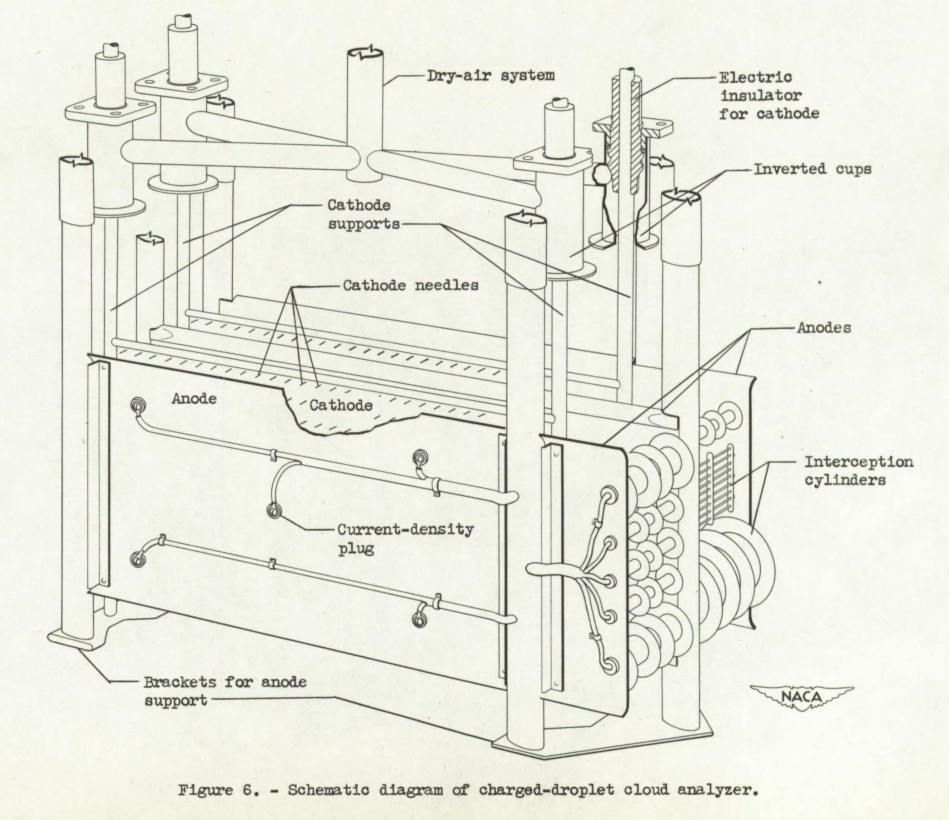
Figure 6 from NACA-TN-2458
Flight tests measured the different electrical charges accumulating on the cylinders.
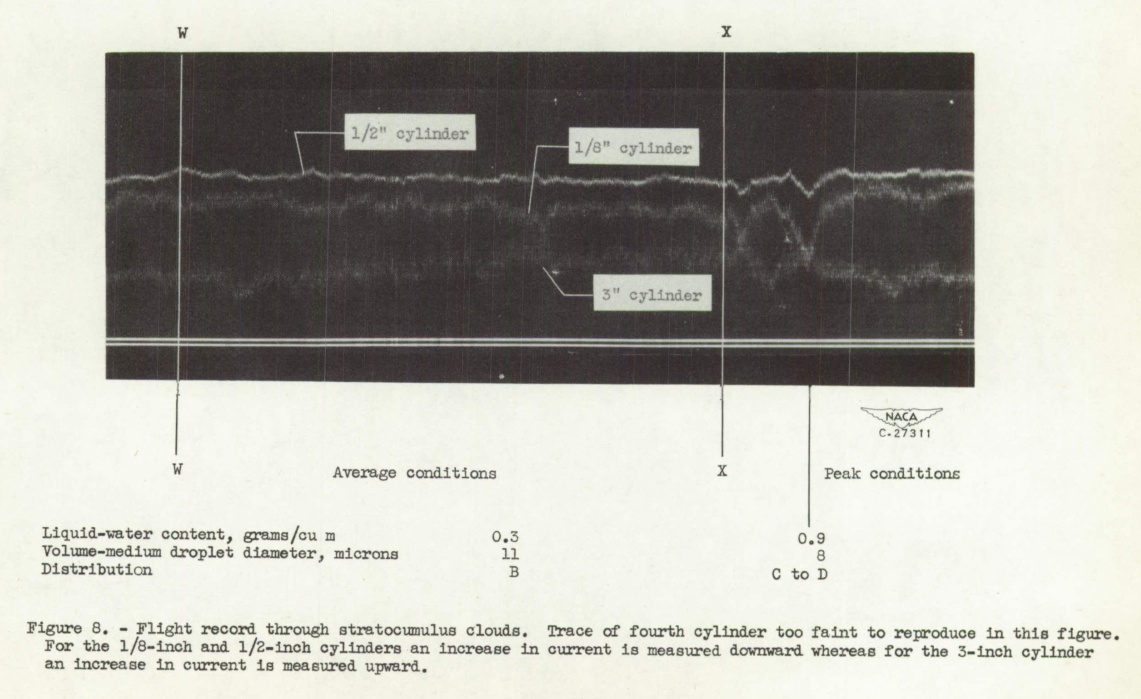
Figure 8 from NACA-TN-2458
The measured charges for each cylinder size were plotted.
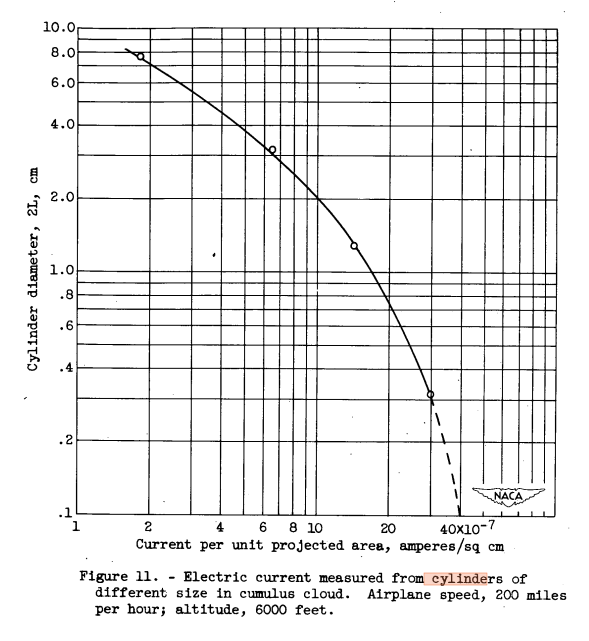
Figure 11 from NACA-TN-2458
From the electrical charge values measured on the cylinders (proportional to the water mass impinging), the collection efficiency for each cylinder diameter could be calculated.
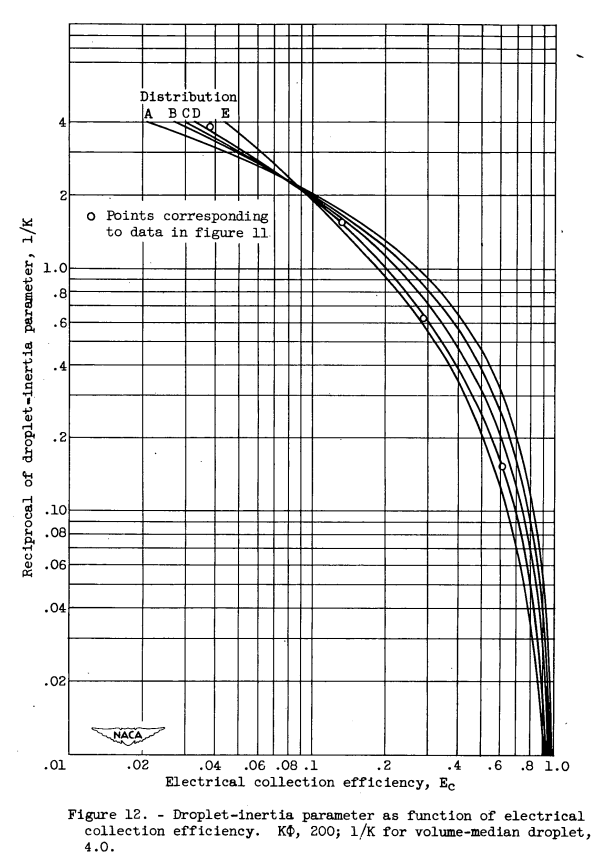
Figure 12 from NACA-TN-2458
From that information the best fit drop size distribution could be calculated. For more details on the multicylinder method calculations, see Implementation of multicylinder calculations in Python.
Conclusions
CONCLUDING REMARKS The charged-droplet cloud analyzer is based on a principle that depends in part on the air flow past the instrument. In this respect the instrument fits naturally into the condition encountered when it is used with an airplane. The location of the instrument on the airplane may be improved perhaps to obtain a more representative sample of the clouds. The first model was placed on the bomb-bay doors for convenience in installation.
The relocation of the instrument would be challenging, given its size.
A difficulty soon realized in the interpretation of the data is the lack of other independent methods for checking the results. The accuracy in determining the liquid-water content and droplet-size distribution depends on: (1) the error in measuring true airspeed, from which the total charge on each droplet, as well as the rate of cloud interception is obtained; (2) the error in measuring electrical values, particularly the galvanometer readings obtained in the form of traces on films (figs. 8 and 9); and (3) the errors in the assumed distributions presented in table I as compared with the natural conditions found in clouds. With the instrumentation on the airplane used for the tests reported herein, the error in measuring true airspeed is about 2.5 miles per hour, which results in a negligible error in determining liquid-water content and volume-median droplet diameter. For the tests with the instrument described, the errors in measuring and reading electrical values varied depending on the type of cloud encountered, because the and the applied errors involved in measuring the current density voltage Vt were insignificant as compared with those involved in reading the film records of the galvanometer. Between the lines WW and XX of figure 8, the distribution actually varied from A to C. At any one point a difference of one distribution was possible when read by different observers. At the peak conditions of the cumulus portion of the cloud (fig. 8), the distribution was C or D, depending on the observer. Whether the distribution was C or D changed the liquid-water content by less than 0.1 grain per cubic meter (less than 10 percent of the original). The errors are much larger in resolving the data where the rate of change of cloud conditions is great, such as at the fringes of a cumulus cloud. Under such conditions it is often difficult to distinguish an E distribution from a B distribution. An improvement in the instrumentation and technique of measuring the current from the cylinders will improve the accuracy.
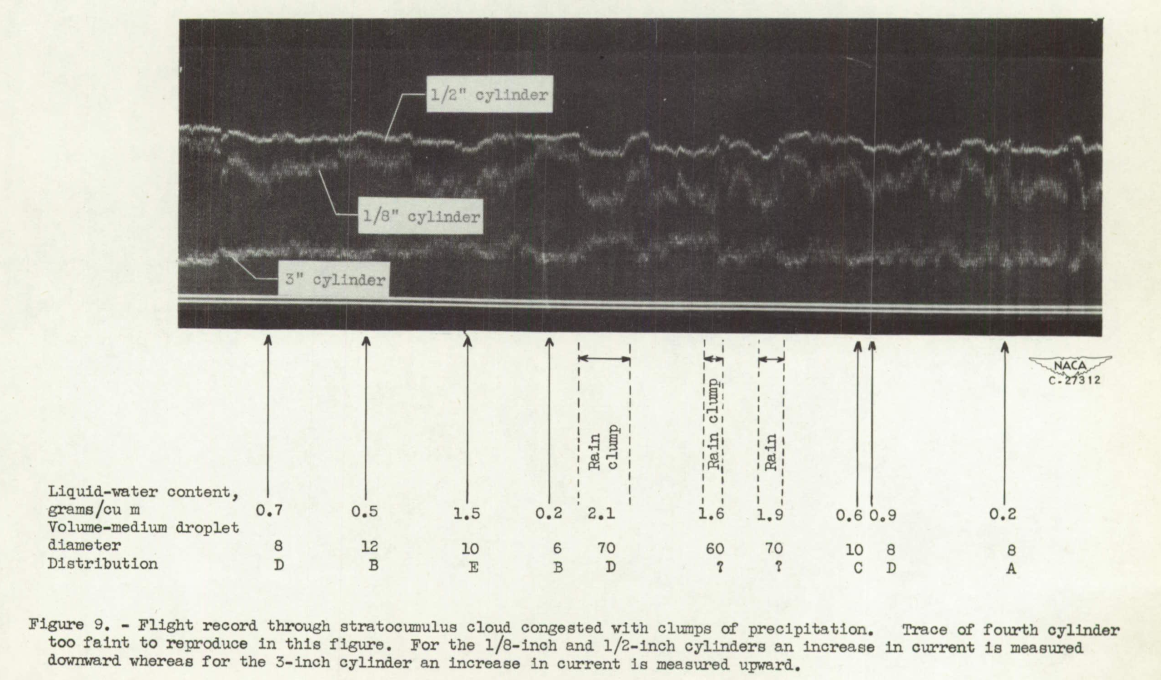
Figure 9 from NACA-TN-2458
You can find out more about the drop size distribution designations (A, B, C, D, E) in the post "Mathematical Investigation of Water Droplet Trajectories".
We saw similar laments many times about the "lack of other independent methods for checking the results" for drop sizes in the Icing on Cylinders Thread. We saw options for measuring drop sizes and size distribution earlier in this Meteorological Instruments Thread, such as the sooted or oiled slide method, or the water drop camera that was also undergoing development at this time (1951). It is not entirely clear why there was not another instrument used for comparison.
However, it is noted that
Because the instrument was designed without anti-icing equipment, flights were necessarily conducted at atmospheric temperatures above the freezing point.
And
The experimental instrument was used to evaluate the method and was not refined to the extent necessary for obtaining conclusive meteorological data.
So perhaps this was more of a "proof of concept" test than a flight instrument calibration test.
The differences in resolving the data by different observers often lie in that the data obtained from the films do not precisely match any calculated distribution curve. The difficulty in matching the curves is caused in part by the scattering of the data and in part by the difference between the assumed distributions presented in table I and the natural conditions existing in the cloud measured. The addition of cylinders larger than 3 inches in diameter may lessen the uncertainty caused by the scattering of the data.
This was another challenge seen several times with the multicylinder method. The largest cylinder was not always large enough to clearly differentiate drop sizes distributions. Cylinder diameters up to 5 and 6 inches were used in the NACA-era multicylinder instruments, but would make for a more unwieldy instrument.
An instrument based on the method of charging the cloud droplets has the following desirable features:
1. The method can be applied in clouds with temperatures above freezing and perhaps in subfreezing temperatures with proper anti-icing equipment.
2. The size and the shape of the cylinders do not change during the exposure time as in the rotating-multicylinder method.
3. The uncertainty caused by the bouncing off of droplets should be much less than if the rotating-multicylinder method because the transfer of charge from the droplets to the cylinders is nearly instantaneous and what happens to the droplets after the charge is transferred is unimportant.
4. The readings are instantaneous and continuous.
5. The available sensitivity permits the study of the local variations in clouds.
6. Weighing errors are eliminated.The analysis of clouds is very difficult with any method requiring cylinders or other obstacles to separate the droplets according to their mass, because both the liquid-water content and the droplet sizes in the clouds are unknowns expressed implicitly in the equations employed. An independent method for measuring liquid-water content in the clouds would permit a simplification in the reduction of the data to droplet size distribution.
I do not know of further development or uses of this instrument.
Citations
NACA-TN-2458 cites 13 publications.
- Langmuir, Irving, and Blodgett, Katherine B.: A Mathematical Investigation of Water Droplet Trajectories. Tech. Rep. No. 5418, Air Materiel Command, AAF, Feb. 19, 1946. (Contract No. W-33-038-ac-9151 with General Electric Co.)
- Katz, R. E., and Cunningham, R. M.: Aircraft Icing Instruments. Instruments for Measuring Atmospheric Factors Related to Ice Formation on Airplanes - II. Dept. Meteorology, M.I.T., March 1948. (Final Rep. under Air Force Contract No. W-33-038-ac-14165, July 1,. 1945-Dec. 31, 1947.)
- Thomson, J. J., and Thomson, G. P.: Conduction of Electricity through Gases. Vols. I and II. Cambridge Univ. Press, 3d ed., 1928.
- Loeb, Leonard B.: Fundamental Processes of Electrical Discharge in Gases. John Wiley & Sons, Inc., 1939.
- Cobine, James Dillon: Gaseous Conductors. McGraw-Hill Book Co., Inc., 1941.
- Townsend, J. S.: Electricity in Gases. Clarendon Press (Oxford), 1915, p. 378.
- Pauthenier, et Mallard: Contribution l etude du champ cylindrique dans l'air ionis & la pression ordinaire. Contr1e expe'rimentai. Coinptes Rendus, T. 189, Nr. 21, Nov. 18, 1929, P. 843-845.
- Clark, Victor F.: The Multicylinder Method. Mt. Wash. Observatory Monthly Res. Bull., vol. II, no. 6, June 1946.
- Anon.: Handbook of Meteorology, F. A. Berry, E. Bollay, and Norman R. Beers, eds. McGraw-Hill Book Co., Inc., 1945.
- Ladenburg, Rudolf: Untersuchungen iber die physikalischenVorgange bei der sogenannten elektrischen Gasreinigung. Teil I. Uber die maximale Aufladung von Schwebeteilchen. Ann. d. Phys., Bd. 4, Heft 7, Folge 5, 1930, S. 863-897.
- Deutsch, Walther: Bewegung und Ladung der E1ektrizitatstrager im Zylinderkondensator. Ann. d. Phys., Bd. 68, No. 12, Folge 4, 1922, 5. 335-344.
- Richtmeyer, F. K., and Kennard, E. H.: Introduction to Modern Physics. McGraw-Hill Book Co., Inc., 4th ed., 1947.
- Lamb, Horace: Hydrodynamics. Dover Pub., 6th ed., 1945.
NACA-TN-2458 is cited once in the NACA Icing Publications Database 2:
- Hacker, Paul T.: An Oil-Stream Photomicrographic Aeroscope for Obtaining Cloud Liquid-Water Content and Droplet Size Distribution in Flight. NACA-TN-3592, 1956. ntrs.nasa.gov
An online search found NACA-TN-2458 cited three times. 3
Notes
-
Brun, Rinaldo J., Levine, Joseph, and Kleinknecht, Kenneth S.: An Instrument Employing a Coronal Discharge for the Determination of Droplet-Size Distribution in Clouds. NACA-TN-2458, 1951. ntrs.nasa.gov ↩